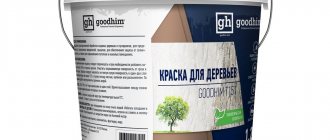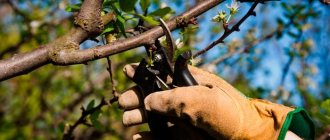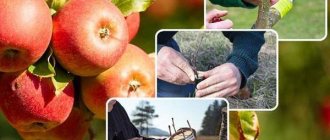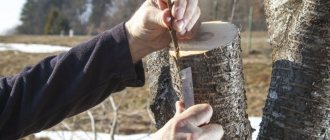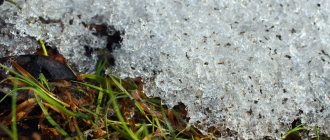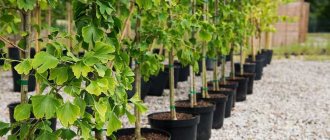Whitewashing is an integral part of caring for fruit trees and shrubs. If earlier summer residents used lime mortar for this purpose, now they prefer to use acrylic garden paint for trees. Acrylic-based compositions are easy to apply and have a high degree of safety - they do not splash, do not cause burns, poisoning or allergies.
Tree paint option.
Main goals and objectives
Gardeners usually treat trunks in the fall. They know why trees are whitened: the procedure helps protect the bark of fruit and ornamental crops from cracking in severe frosts. At this time, all living things in nature, including insects, are preparing for the cold. They are looking for a reliable shelter where they can safely hibernate and hold out until the first warm weather. The best place for this is under the bark of a tree. You can get there by crawling into cracks. Whitewashing them in the fall will cement the weak points and prevent pests from finding a cozy home.
High-quality whitewashing of trees in the spring is a preventive measure. It is aimed at destroying pathogens that still managed to overwinter in the top layer of soil. In addition, treating skeletal branches with lime prevents burns. In spring, the sun becomes active; a simple procedure allows you to protect the bark from overheating while there is still no foliage on the crown. Therefore, experienced gardeners always whiten the trees on their site twice a year.
Whitewashing protects against sun burns Source www-cdn.intex-press.by
Pros and cons of painting trees
Do you apply paint to the trees in your garden?
Of course! I want to try it
Treatment of tree trunks with painting material is carried out at any time of the year only in dry and windless weather. In the spring, this work is carried out until the ground warms up and insects awaken in it. In the absence of autumn painting of plants, in the spring the tree bark is covered with special compounds twice: in the third ten days of February and in mid-April.
The temperature during spring work should exceed 0 degrees. The composition should not be hazardous to the surface of plants. To apply the compositions to the trunks, paint brushes or sprayers are used.
Advantages of spring tree painting:
- protecting the bark from burns from the scorching rays of the sun;
- Gives plantings an aesthetically attractive appearance.
Autumn painting of trees allows you to rid their bark of mites, flower beetles, lacewings, aphids, codling moths and leaf rollers that penetrated it in the summer. The procedure can significantly reduce the amount of pathogenic microflora and bacteria in the trunks. Trees coated with garden paint freeze less in winter.
Expert opinion
Levin Dmitry Konstantinovich
Before applying it to the trunks, they are cleaned of moss, lichen and disinfected. A 3-5% solution of copper sulfate can be used as a disinfectant solution. On tree trunks older than 5 years, garden paint is applied in 2 layers.
Perfect time
It is best to start whitening trees in late February or early March. During this period, the trunks warm up to +11 ºC, so there is a risk of the formation of early sap movement. In spring, night temperatures are still too low. Often the thermometer readings drop below -11 ºC. At such indicators, the juice can freeze and tear the trunk tissue from the inside.
When this happens, frost holes form. Experts, talking about why tree trunks are whitened in the spring, draw attention to the fact that white paint can repel the sun's rays. In this way, the juice is prevented from moving earlier. Fruit and ornamental crops wake up later, on time, when it is completely safe for them.
Frost holes on tree branches Source hozyain.by
Why whiten trees in autumn?
Autumn whitewashing of trees pursues the following goals:
- combating insect pests that lay eggs in the folds of the bark and themselves settle in for the winter;
- disinfection of wounds and damage to prevent the penetration of pathogenic microorganisms into the inner layers of wood;
- protection from bright, scorching sun rays that can leave deep, traumatic burns on tree bark;
- leveling the consequences of sudden temperature changes, which cause cracking of the outer cover (frost holes);
- repelling various rodents (mice, hares, etc.).
All trees need autumn whitewashing
Concentrated whitewash can cause significant harm to the delicate bark of young trees, as it clogs pores and causes chemical burns. But if you use compounds in half concentration or special “breathable” coatings for young garden trees (water-dispersed, acrylic or water-based), then the likelihood of damage is significantly reduced.
Video: is it necessary to whitewash trees?
Preparations for whitewashing
You can treat trunks in the spring with different mixtures. It is better to use those that have three required components:
- White pigment (lime or chalk), only this color is able to reflect ultraviolet radiation and prevent it from overheating the bark.
- An adhesive base, it should allow the solution to adhere to the trunk and prevent it from draining from the bark ahead of time.
- An antiseptic is a fungicide that will destroy the infection that has awakened after hibernation.
Our ancestors also knew why tree trunks were whitened. They used slaked lime or chalk solution for these purposes. This procedure provided a temporary effect, since the solution was quickly washed away by spring rains or it simply crumbled after drying. Today, gardeners prefer to prepare complex compositions based on the listed components.
The main component for a solution suitable for whitewashing trees Source gidpokraske.ru
See also: Catalog of popular plots in the Moscow region for the construction of a country house.
For the first, they carefully mix three kilograms of slaked lime, ten liters of clean water and half a kilogram of copper sulfate, add 100 grams of casein glue or a couple of spoons of paste made from flour. Then the finished solution is infused for several hours, after which it is applied to the trunks.
For the second, two kilograms of slaked lime are dissolved in ten liters of water, a shovel of manure and a kilogram of fatty clay are added, 250 grams of copper sulfate are mixed in, and then left for two hours.
For the third, take 400 grams of copper sulfate, add it to very hot water (8 liters), stir thoroughly, then add 100 grams of casein glue and two kilograms of slaked lime.
A wide brush is the best tool for whitewashing Source seattlehelpers.org
The finished compositions are applied to the trunks of garden and ornamental crops with a large brush with thick bristles. Not everyone knows how to dilute lime for whitewashing trees. It is important to prepare a solution of such thickness that it does not flow from the trees during processing and is laid down in a layer whose thickness after drying does not exceed 2 mm. If the solution is thick, it will form a thick layer, which will very quickly crack and crumble. To prevent this from happening, experienced gardeners advise taking three kilograms of lime, pouring it into a large metal bucket and filling it with four liters of water.
See also: Catalog of companies that specialize in the development and installation of greenhouses and winter gardens.
Ready-made paint for whitewashing trees
If you choose a method of treating trees with solutions based on chalk and slaked lime, you will need to update the layer once a month and re-paint the trunks and branches. When this is not possible, experts advise using water-based paints for whitewashing. After their application, a layer is formed on the surface of the bark that allows air to pass through, but blocks ultraviolet rays. It lasts for two years, which significantly simplifies the process of garden care. Painting can be done when the air temperature in spring warms up to + 3ºC.
Ready-made garden paint Source urovenkna.ru
When it is not possible to buy ready-made paint, you can prepare a solution of two parts PVA glue, one part chalk with the addition of any antiseptic intended for treating wood. After all the ingredients are combined, they are added to the water in small portions. This must be done constantly, stirring. It is important to achieve the thickness of oil paint in this way.
Purpose, types, properties
Experts recommend painting the trunks of fruit trees twice a year: in spring and autumn. This procedure plays a decorative and preventive role. Garden paint protects tree trunks from pests and pathogenic microbes. Along with this process, damaged areas of wood are disinfected. In spring, paint is applied to tree bark in March-April, and in autumn in October-November.
Do not apply a thick layer of paint to young plants with thin bark.
Special gentle formulations are produced for seedlings. All types of garden paint produced by manufacturers are divided into groups:
- water-based;
- water-dispersed;
- alkyd;
- aerosol.
Garden paint applied to the bark of plants can effectively repel small rodents and hares from it.
Water-based
Most formulations are based on acrylic resins. They prevent tree bark from rotting and kill bacteria. The disadvantage of this type of paint is that it does not protect trees from pests. To increase the effectiveness of the compositions, special substances containing copper are added to them before use. You can paint trees with them only in calm, warm weather.
Advantages of water-based compositions:
- reliable protection against pathogenic microorganisms and temperature changes;
- economical consumption;
- create a durable breathable layer.
Flaws:
- the need to add copper to compositions;
- cannot be used in rainy or windy weather.
Water-dispersed
The compositions contain antiseptics. They effectively protect tree trunks from pests. The durability of the coating is ensured by the latex contained in the paints, and the pigments prevent ultraviolet rays from destroying the wood structure.
Advantages of water-dispersed compositions:
- the presence of antiseptic and insect and rodent repellent properties;
- high degree of moisture resistance.
Flaws:
- cannot be used at temperatures below 7 degrees, in rainy and windy weather;
- the compositions and properties of different brands of paints of this type have significant differences.
Alkyd
Emulsions of this type in some cases can serve as a plant growth stimulator. They increase the frost resistance of plants, dry quickly and do not have a pungent odor.
Advantages of alkyd compositions:
- increased resistance to moisture;
- budget cost;
- create a durable breathable layer;
- quick drying.
Flaws:
- inferior in plant protection efficiency to acrylic garden paints;
- presence of an unpleasant pungent odor.
Aerosol
The mixtures are convenient for spraying in hard-to-reach places. Aerosol garden paints reliably protect plants from diseases and pests.
Advantages:
- ease of use;
- deep penetration into wood.
Flaws:
- high price;
- high consumption.
Whitewashing tools
Typically, gardeners use washcloths for designated purposes. But whitening them is not very convenient. It will be much easier to work with a paint brush with synthetic bristles. The maklovitsa helps to cover a large area with one movement of the hand. It is easy to work with both when the bark has a smooth structure and when the tree trunks are covered with deep cracks. If the garden is large and there are tall trees in it, it is better to whiten them with a spray gun. It will be faster and less labor intensive.
Whitewash brush Source stalevar.ua
Processing technology
It is not enough to know how to slak lime for whitewashing trees and how to prepare solutions for this. You need to be able to conduct thorough preparations for a responsible event. Experienced gardeners first walk around their property and carefully study the condition of the fruit-bearing trunks and the lower third of the skeletal branches, clearing them of dead bark. To do this, they spread a large old rag under the tree, and then with a wooden (not metal) scraper they very carefully tear off what easily comes off the trunk. Trees tolerate this operation more easily if it is performed in cloudy weather. Any remaining bark that has fallen onto a rag must be burned. Pests may remain in it.
Stripping dead bark Source i.ytimg.com
Preparing for work
Whitewash can be applied only to those plants that have already begun to bear fruit. Young seedlings purchased last season may not tolerate this procedure and die. They are usually wrapped for protection with any covering material other than plastic film.
Before starting processing, it is important to properly prepare the trees. They must be carefully cleaned of diseased and old bark, moss and lichen. To remove lichen, you can use a special solution. It is prepared as follows: 1 kg of salt, 2.5 kg of ash and two pieces of pre-crushed laundry soap are mixed in one container. Then you need to pour in a bucket of hot water and boil. Use a cooled mixture to wash off all the moss from the trunks. It is best to separate the old bark by hand, since the use of scrapers, brushes and spatulas can injure the plant.
If fresh damage is found on the tree, they must be treated with garden varnish. Instead, they often use a mixture of clay and manure, oil paint or beeswax with the addition of rosin.
Before you start bleaching, you can additionally coat the trunks with a disinfectant composition.




